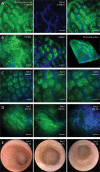Label-Free Multiphoton Endomicroscopy for Minimally Invasive In Vivo Imaging
- PMID: 31016109
- PMCID: PMC6468963
- DOI: 10.1002/advs.201801735
Label-Free Multiphoton Endomicroscopy for Minimally Invasive In Vivo Imaging
Abstract
Multiphoton microscopy of cellular autofluorescence and second harmonic generation from collagen facilitates imaging of living cells and tissues without the need for additional fluorescent labels. Here, a compact multiphoton endomicroscope for label-free in vivo imaging in small animals via side-viewing needle objectives is presented. Minimal invasive imaging at cellular resolution is performed in colonoscopy of mice without surgical measures and without fluorescent dyes as a contrast agent. The colon mucosa is imaged repeatedly in the same animal in a mouse model of acute intestinal inflammation to study the process of inflammation at the tissue level within a time period of ten days, demonstrating the capabilities of label-free endomicroscopy for longitudinal studies for the first time.
Keywords: endoscopy; inflammatory bowel disease; multiphoton microscopy; optical imaging.
Conflict of interest statement
The authors declare no conflict of interest.
Figures




References
-
- Waldner M. J., Wirtz S., Neufert C., Becker C., Neurath M. F., Nat. Protoc. 2011, 6, 1471. - PubMed
-
- Kiesslich R., Burg J., Vieth M., Gnaendiger J., Enders M., Delaney P., Polglase A., McLaren W., Janell D., Thomas S., Nafe B., Galle P. R., Neurath M. F., Gastroenterology 2004, 127, 706. - PubMed
-
- Atreya R., Neumann H., Neufert C., Waldner M. J., Billmeier U., Zopf Y., Willma M., App C., Munster T., Kessler H., Maas S., Gebhardt B., Heimke‐Brinck R., Reuter E., Dorje F., Rau T. T., Uter W., Wang T. D., Kiesslich R., Vieth M., Hannappel E., Neurath M. F., Nat. Med. 2014, 20, 313. - PMC - PubMed
-
- Zipfel W. R., Williams R. M., Webb W. W., Nat. Biotechnol. 2003, 21, 1369. - PubMed
LinkOut - more resources
Full Text Sources
Other Literature Sources
